5G has been set as the successor to 4G, and the expansion of the mobile communications standard is progressing rapidly. What is to be understood by 5G, which areas of application exist today, and what advantages and disadvantages the new standard brings. The 5G mobile communications standard is based on the predecessor 4G, also known as LTE, and promises data rates of up to 10 Gbit/s and shallow latency times, among other things.
What Is 5G?
5G is the fifth generation of mobile communications and thus the direct successor to 4G (LTE). In contrast to its predecessors (4G, 3G, and 2G), the new standard offers significantly increased data rates, lower latency, and new frequency ranges. 5G is also referred to as digitization because it enables data transmission in real-time.
This results in new areas of application for digitization for both end-users and industry in the context of the Internet of Things. In addition to the advantages, the standard also brings new challenges: For example, the number of transmission masts must increase compared to 4G to set up a nationwide 5G network.
What Does 5G Mean?
Compared to previous cellular standards, 5G can be adapted to the needs of local users. While with 4G, the population density was still decisive for the number of base stations, with 5G, the focus is on the applications: In an industrial area with intelligent factories, a broadband network is required in which a large number of IoT devices can communicate.
On traffic routes, on the other hand, (partly) autonomous vehicles need short latency times and reliable connections. The performance of networks will therefore differ significantly in the future. In addition, highly specialized local networks are being set up. For example, companies already use so-called campus networks, which enable networked production via 5G but are not connected to the public network.
How Fast Is 5G?
In particular, cell phone providers like to advertise that 5G should be up to 100 times faster than LTE. To check this, it is worth taking a look at the latency pages and the possible download speeds:
Latency Of 5G
5G enables a latency of less than 1 ms (4G: 60 to 98 ms). Under ideal conditions, the connection between the end device and the base station (also known as the air interface) can be around 100 times faster than 4G. In reality, however, the latency between the base station and the network and the latency of the servers involved must also be taken into account.
Download Speed With 5G
5G also promises a significant improvement over LTE regarding downloading. While download speeds of up to 1 GBit/s were still possible with the 4G standard, 5G can achieve download speeds of up to 10 GBit/s. But how does the network behave in reality? Telekom used a 5G network at IFA 2018. According to the company, a download speed of 3 GBit/s was achieved at this significant event, at least 300 percent faster than 4G could ever be. If 10 GBit/s is completed in practice, users with a smartphone could, for example, download the content of a DVD (4.7 GB) within four seconds.
Where Is 5G Already Available?
Four companies are responsible for the 5G expansion in Germany, which acquired 5G frequencies at the 2018 license auction. These are: Telekom, Vodafone, 02 Telefonica and Drillisch (1&1). Since the network architecture of the new standard is much more fragmented, partial improvements in the network are the main features. Therefore, the availability can vary depending on the district or even the street. Here you will find an interactive map of the 5G expansion.
Also Read: 5G Network: What It Is, How It Works?

